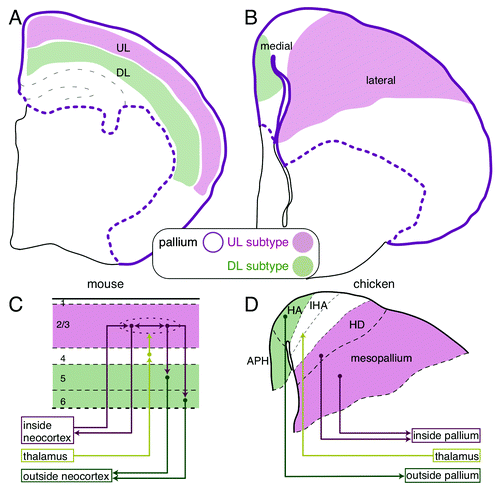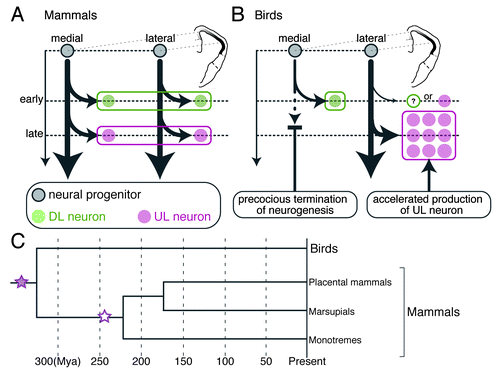Figures & data
Figure 1. Comparison of the mammalian and avian pallial architectures. (A) The layered neocortex of the mouse. The upper and deep layer (UL and DL) neuron subtypes are tangentially arranged in the pallium. (B) UL and DL neuron subtypes are arranged separately in the medial and lateral domains of the chick pallium, respectively. (C and D) Similarity of the neural circuits in the mammalian neocortex and the avian pallium. (C) The columnar neural circuit in the mammalian neocortex. The input from the thalamus terminates in the layer 4. The information is transferred to and processed in the UL (layer 2/3) neurons that are connected with each other inside the neocortex, and finally output by the DL (layer 5 and 6) neurons to extracortical targets. (D) In the avian pallium, the thalamic input is received by the neurons in the central domain of the hyperpallium (IHA), which is sandwiched by the medial (HA and APH) and lateral domains (HD and mesopallium). The medial and lateral domains project to the intrapallial and extrapallial targets, respectively.

Figure 2. Animal group-specific neurogenesis in the pallium and the potential evolutionary history of pallial bioarchitecture during the evolution. (A and B) Comparison of the pallial neurogenesis between mammals and birds. The gray, green and magenta circles indicate the neural progenitor, DL and UL subtypes, respectively. The arrows indicate the neurogenetic process. (A) Spatially unbiased progression of neurogenesis constructs homogeneous layers of neuron subtypes across the mammalian neocortex. (B) The spatially biased neurogenesis constructs the mediolaterally separated subtype arrangement in the avian pallium. (C) Hypothetical evolutionary scenario of the emergence of the neocortical layer architecture. Neocortical layer-specific neuron subtypes originated from the common ancestor of the mammals and birds (purple filled star). The layered arrangement of neuron subtypes newly emerged (white star) in the mammalian lineage before the branch leading to the monotremes. Illustrations in (A and B) are reproduced with permission from reference Citation22.
